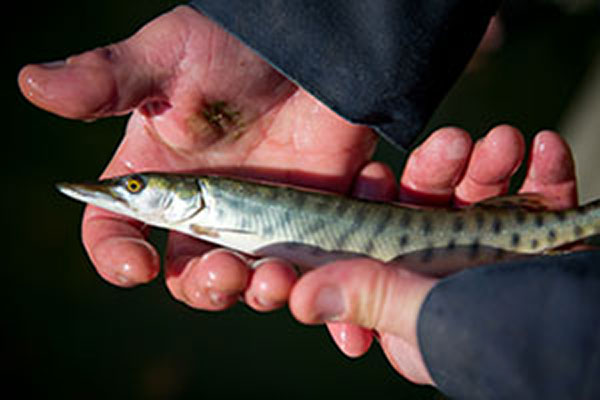By Louie Stout
 Young Muskie Fingerling
Young Muskie Fingerling
Good news for Indiana muskie anglers – the Indiana DNR will resume collecting eggs from Webster Lake’s adult fish this year.
The project, along with walleye egg taking in southern Indiana, was canceled last year due to the pandemic, but Northern Supervisor Jeremy Price said crews will be back at work with muskie in early April.
“Barring any unexpected change in the virus, we’re good to go,” he said.
Biologists hated skipping a year last season, but say missing one year with muskies won’t be real noticeable.
“Muskies live a long time and we have documented fish in there up to 16 years old,” said Price. “And since we have been stocking every year, it shouldn’t affect the fishery to miss one year.”
The DNR will set up an on-the-water lab while it catches adult male and female muskies, collects their eggs and milt. Survivors will be released back into the lake and the fertilized eggs will be taken immediately the Fawn River Hatchery.
Some of those fish will go into Webster this fall as 10-inch fish while the remaining will be held at the hatchery over winter and stocked next spring as slightly larger fish.
“We’re experimenting with those spring stockings,” said Price. “There is more food available in the lake during spring than there is during the winter. We’re hoping the survival rate is even better.”
Muskies will go into Webster, Tippecanoe, Bruce, and Skinner lakes as well as the Barbee Chain this fall.
“We’re hoping to get enough eggs to put some extra fish into the Barbee Chain,” Price added.
Walleyes took a hit
The walleye issue is a bit more of a concern. Since walleyes are stocked in alternate years in northern lakes, missing an egg-taking season means some lakes may go without fish for three years.
“Fortunately, we were able to buy some walleyes from a private hatchery last season and get some fish stocked in our waters,” Price said.
Walleyes are captured for eggs at Brookville Reservoir and those fish are taken to Cikana and Fawn River hatcheries.
Walleyes are stocked in three phases; as fry, as June finglerlings and as fall fingerlings. Fry typically don’t do well in many lakes but seem to do well at Bass Lake.
The bigger and more mature fingerlings show higher survival, but they also occupy a lot of hatchery space and cost more in feed and manpower when kept for extended periods.
That’s why Indiana still buys some fish from private hatcheries and is looking at ways to expand its own production.


